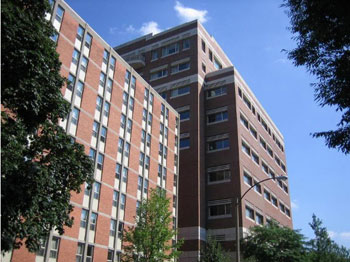 In this post I am going to argue that college dormitories provide a better way of estimating real income than the CPI.
In this post I am going to argue that college dormitories provide a better way of estimating real income than the CPI.
Each year I get more like my dad, who was a reactionary liberal. He voted liberal but always complained about how easy things were for the younger generation. Every time I drive into Boston I think about him as I pass by a 30 story tower with large floor to ceiling plate glass windows. There must be fantastic views of the Charles River, Cambridge, and downtown Boston. The newest Trump Tower? No, it’s the newest Boston University dorm. And it’s not unique, nearby are two more towers that are slightly older, slightly lower, and slightly less elegant. I can only imagine what it would be like to live in one of those high rise towers. Imagine the parties; students strolling around with martinis in hand, discussing all sorts of fascinating topics. What a life! Here is a picture if you don’t believe me. (Here and here are some views.)
And it isn’t just BU, which is an above average university. The new dorms at Bentley are also much nicer than the old ones, and I’m told this trend is going on all across America. When I ask my colleagues why students need such fancy digs, they tell me that things are different now. (I first entered the UW in 1973.) Our generation often grew up in modest ranch houses with one bathroom. We doubled up with bunk beds. Now students grow up in 4 or 5 bedroom houses, each kid has their own bedroom. There might be three or four bathrooms. Granite counter-tops, big screen TVs. Two car garages. Many students now drive their own car to high school.
I’m told colleges have to do this or they will lose students to other schools. My colleagues say “Times change, just deal with it and stop being such a reactionary.” (Well the last sentence I made up; my younger colleagues are too polite to say it, but that’s what they are thinking.)
On the other hand David Johnston claims that if we deflate incomes by the CPI, it seems like were are living in a poorer country than we inhabited in 1973:
America grew and grew during this era. GDP, adjusted for inflation and increased population, was up 227 percent. But wages and fringe benefits did not grow with the economy. For most workers, they fell. Wages peaked way back in 1972-1973, were on a mostly flat trajectory for more than two decades, rose briefly in the late 1990s, and then fell sharply in the new century. … Millions are out of work, and the jobs they once held are … not coming back. And even if the Great Recession is coming to an end, we face years of jobs growing more slowly than the working-age population, which could radically transform America’s culture, work ethic, and sense of progress.
I don’t know what to make of these arguments. I find it hard to think of a single area where American living standards aren’t obviously much higher than 1973:
- Houses are bigger and have more baths.
- Electronics are so much better it is ridiculous. 100 times as many TV channels.
- We take jet vacations to Disney World or Europe, not car trips to a state park.
- Granite counter-tops vs. Formica.
- Thai or sushi restaurants vs. meat and potatoes “supper clubs.”
- Better medical care and longer life expectancy.
- Cars with paint that doesn’t rust out in three years.
- For the lower middle class: Wal-Mart vs. K-Mart.
- No more purple shag carpets.
- U2/Radiohead vs. Dylan, the Beatles and the Stones.
OK, pop music is an exception, but nine out of ten ain’t bad. And there is lots more I could point to. We have much cleaner air and water. Less racism, sexism and homophobia. Much less violent crime. Is the composition of college students different? Yes, but that actually strengthens my argument.
So what do you guys think? Do you agree with me that dorm quality is the best proxy for living standards? Or are you going to take what has been the intellectually fashionable position since ancient times—that things were better in the old days?
PS. Don’t try to tell me I am ignoring the poor. There are also far fewer Americans that live in shacks that lack indoor plumbing.
- Bulenox: Get 45% to 91% OFF ... Use Discount Code: UNO
- Risk Our Money Not Yours | Get 50% to 90% OFF ... Use Discount Code: MMBVBKSM
Disclaimer: This page contains affiliate links. If you choose to make a purchase after clicking a link, we may receive a commission at no additional cost to you. Thank you for your support!


Enough about the “luxury” dorm at BU. Are those of you who complain about it telling folks that new space should be as ugly and non-functional – and as energy inefficient – as it was in the good old days? If you have to add 1000 beds because you must house a certain proportion of your students on campus per the city and you have a limited footprint on which to build, there is only one way to go, and that is up. Aside from the views, the only things “luxurious” about this building are its new finishes (duh), real group study spaces, wireless, and LEED silver-level energy efficiency. These are things that any good steward of resources would include in new living space. So, are new dorms the new living standard? In some ways, I hope so, if by “living standard” we mean sustainable design and efficient use of scarce resources. But if you mean the so-called ‘luxury’ finishes and perks, the analogy is way off base.